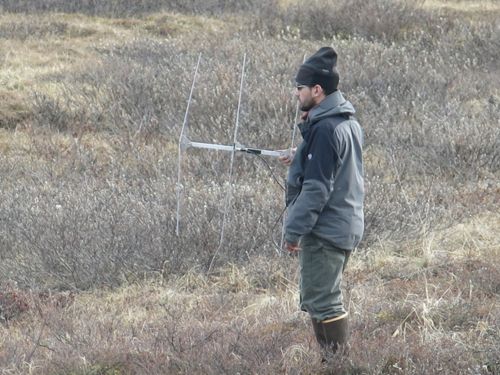There are strange things done 'neath the midnight sun,
By the tundra birds that toil..... The arctic trails have their secret tales,
That just might surprise you!
Among the many science teams working in the Toolik area are some looking at the breeding biology of various tundra nesting bird species. Each of the birds found here have an unusual story. For one thing, just to be here can be a challenge. Birds either have to live here year round, like the ptarmigan, or migrate from the south. Hibernation in birds is extremely rare, one example being the common poorwill, which may spend several weeks at a time in a state of torpor while lodged in a rocky crevice, but these do not live in the arctic (Csada, 1992). To cope with the demands of survival there are a variety of breeding strategies; each one fine tuned by evolution to maximize survival of the young. The vast majority of birds, around 92%, have a reproductive strategy known as social monogamy where the male and female form lasting pair bonds, mate and share responsibility in caring for the young. The majority of humans practice this strategy, not always on a permanent, or equitable basis. At Toolik, a pair of resident loons returned this week. Loons are generally monogamous, returning to the same location with the same mate from year to year. Their haunting call has been waking me up the last few nights. I love it, though. It is a nice reminder that I am in a strange land!
 a pacific loon (Bill Schmoker photo)
a pacific loon (Bill Schmoker photo)
To hear the eerie call of the loon, follow the link:
In polygynous mating, one male may have a territory that he defends and may mate with several females. After mating, the male provides no help with the offspring. We see this in humans also. The rock and the willow ptarmigan here at Toolik can be either monogamous, or if given the opportunity, polygynous. It is interesting to note that the ptarmigan males keep their white plumage for an extra three weeks after winter to attract mates. During this time the females molt and become exceptionally well camouflaged. This is know as cryptic coloration. The white males are highly visible to females, and to predators. The sexual selection of all white males must be stronger than the natural selection of predators that can easily locate the males, otherwise all the males with the white feather genes would have been eaten long ago.
 the male willow ptarmigan retains much of its white winter coat to attract mates, despite its high visibility to predators.
the male willow ptarmigan retains much of its white winter coat to attract mates, despite its high visibility to predators.
One group of scientists we met in the field is studying a particularly strange mating behavior in a bird called the Smith's Longspur. These ground nesting song birds practice polygynandry, where the female mates with several males, and lays eggs fertilized by all of them. Meanwhile, the males will mate with 2-3 females. What is surprising is that multiple males will help the females care for the young, even if the nestling is not their own. The female birds will defend and fight off other females trying to lure the males away. Only about 0.1% of bird species have this sort of mating system. To keep track and understand all the complex relationships in a group of longspurs, biologists have to carefully watch then catch the birds, band them, and sometimes attach a tiny radio transmitter to the feathers so the bird can be followed. Blood samples can be taken to test for hormone changes and for DNA profiling (DNA Fingerprinting). These tools help scientists to be certain of the familial relationships (pedigree) of each adult bird and hatchling (Briskie, 2009). Careful analysis has helped us to unravel the unusual mating behavior.
 Johnathon tracking radio tagged songbirds
Johnathon tracking radio tagged songbirds
Another interesting strategy is called polyandry. The red necked phalarope practices this strategy, where the traditional roles are reversed. In phalaropes, the female has the bright colors to attract a mate, and the drab colored male sits on and incubates the eggs. Once the male has started to brood the eggs, the female will leave and seek out a new male to mate with and start a new nest. After those eggs are being carefully guarded by the father, mom moves on once again...(Reynolds, 1987; Rubega, 2000)
 the male red necked phalarope incubates the eggs and cares for the chicks while the female runs off to find another mate.
the male red necked phalarope incubates the eggs and cares for the chicks while the female runs off to find another mate.
Just for fun, I was reminded of the Robert Service poem, The Cremation of Sam Magee.
"There are strange things done 'neath the midnight sun By the men who moil for gold. The arctic trails have their secret tales That would make your blood run cold. The northern lights have seen queer sights But the queerest they ever did see, Was that night on the marge of Lake LeBarge When I cremated Sam McGee."
Briskie, JV (2009) Smith’s Longspur (Calcarius pictus), The Birds of North America Online (A. Poole, Ed.). Ithaca: Cornell Lab of Ornithology; Retrieved from the Birds of Nroth America Online
Csada, R. D. and R. M. Brigham. 1992. Common Poorwill (Phalaenoptilus nuttallii). In The Birds of North America, No. 32 (A. Poole, P. Stettenheim, and F. Gill, Eds.). Philadelphia: The Academy of Natural Sciences; Washington, DC: The American Ornithologists' Union.
Reynolds, JD (1987) Mating system and nesting biology of the Red-necked Phalarope: what constrains polyandry. Ibis, 129 225-242
Briskie, JV (2009) Smith’s Longspur (Calcarius pictus), The Birds of North America Online (A. Poole, Ed.). Ithaca: Cornell Lab of Ornithology; Retrieved from the Birds of North America Online.


Comments